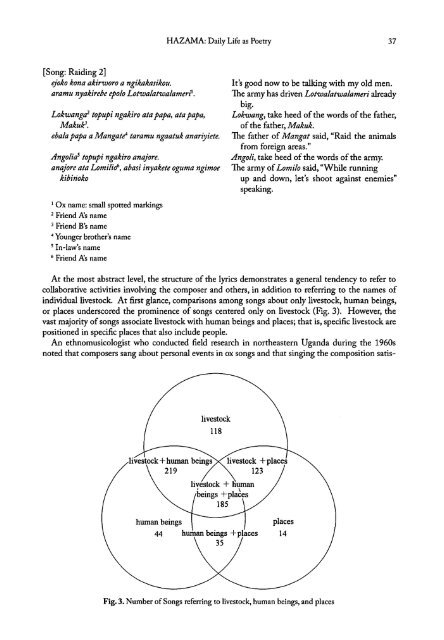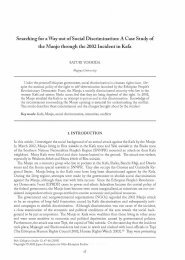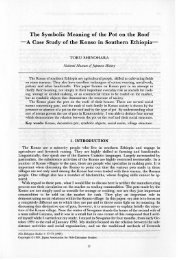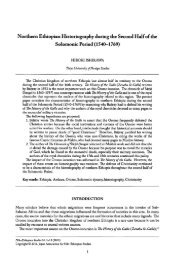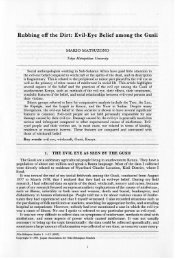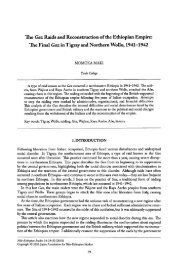Daily Life as Poetry: The Meaning of the Pastoral Songs of the ...
Daily Life as Poetry: The Meaning of the Pastoral Songs of the ...
Daily Life as Poetry: The Meaning of the Pastoral Songs of the ...
Create successful ePaper yourself
Turn your PDF publications into a flip-book with our unique Google optimized e-Paper software.
HAZA.MA: <strong>Daily</strong> <strong>Life</strong> <strong>as</strong> <strong>Poetry</strong> 37<br />
[Song: Raiding 2]<br />
e.foko kona akirworo a ngikak<strong>as</strong>ikou.<br />
aramu nyakirebe epolo Lotwalatwalameri 1 •<br />
Lokwangfil topupi ngakiro ata papa, ata papa,<br />
Makuk1.<br />
ebala papa a Mangate 4 taramu ngaatuk anariyiete.<br />
Angolia 5 topupi ngakiro ana.fore.<br />
ana.fore ata Lomilio 6 , ab<strong>as</strong>i inyakete oguma ngimoe<br />
kibinoko<br />
It's good now to be talking with my old men.<br />
<strong>The</strong> army h<strong>as</strong> driven Lotwalatwalameri already<br />
big.<br />
Lokwang, take heed <strong>of</strong> <strong>the</strong> words <strong>of</strong> <strong>the</strong> fa<strong>the</strong>r,<br />
<strong>of</strong> <strong>the</strong> fa<strong>the</strong>r, Makuk.<br />
<strong>The</strong> fa<strong>the</strong>r <strong>of</strong> Mangat said, "Raid <strong>the</strong> animals<br />
from foreign are<strong>as</strong>."<br />
Angoli, take heed <strong>of</strong> <strong>the</strong> words <strong>of</strong> <strong>the</strong> army.<br />
<strong>The</strong> army <strong>of</strong> Lomilo said, "While running<br />
up and down, let's shoot against enemies"<br />
speaking.<br />
1<br />
Ox name: small spotted markings<br />
2<br />
Friend Its name<br />
3<br />
Friend B's name<br />
4<br />
Younger bro<strong>the</strong>r's name<br />
5<br />
In-law's name<br />
6<br />
Friend Its name<br />
livestock<br />
118<br />
At <strong>the</strong> most abstract level, <strong>the</strong> structure <strong>of</strong> <strong>the</strong> lyrics demonstrates a general tendency to refer to<br />
collaborative activities involving <strong>the</strong> composer and o<strong>the</strong>rs, in addition to referring to <strong>the</strong> names <strong>of</strong><br />
individual livestock. At first glance, comparisons among songs about only livestock, human beings,<br />
or places underscored <strong>the</strong> prominence <strong>of</strong> songs centered only on livestock (Fig. 3). However, <strong>the</strong><br />
v<strong>as</strong>t majority <strong>of</strong> songs <strong>as</strong>sociate livestock with human beings and places; that is, specific livestock are<br />
positioned in specific places that also include people.<br />
An ethnomusicologist who conducted field research in nor<strong>the</strong><strong>as</strong>tern Uganda during <strong>the</strong> 1960s<br />
noted that composers sang about personal events in ox songs and that singing <strong>the</strong> composition satishuman<br />
beings<br />
44<br />
places<br />
14<br />
Fig. 3. Number <strong>of</strong> <strong>Songs</strong> referring to livestock, human beings, and places


